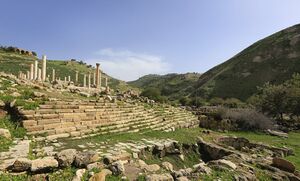Parilla
Parilla
Парила | |
|---|---|
City | |
 Ruins of Parilla | |
| Founded | ~600 BCE |
| Destroyed | 1456 |
| Population | |
| • Total | 1,000,000 + (800 CE) |
Parilla was an ancient city that served as the capital of the Symmerian Empire throughout its duration, located near the modern city of Patom in Symmeria on the Dazin River. At it's peak, the population of Parilla surpassed 1 million inhabitants and it was among the largest city in all Tyran.
Parilla was founded sometime in the 7th Century BCE prior the establishment of Ancient Symmeria, but by 556 BCE had become the capital of Symmeria and remained so until the Fall of the Symmerian Empire. Parilla contained within it the Palace of the Basileus, the seat of power for the Symmerian King, as well as the Royal Court, the Pantheon of the Symmerian faith (later the Temple of the All-Mother following the adoption of Zobethos), and the Royal Mausoleum. Parilla grew along with the Empire and became the epicenter of Symmerian political, economic, and military authority. Riches from across the Empire drawn from conquests and trade were gathered, sold, and displayed across Parilla, and the city became a major site of cultural and social interaction for people from across Siduri.
The site that would become Parilla was inhabited since the Archaic age, but grew significantly during the Classical Age and became the seat of power of the Symmerian Kingdom when it was established by Epikharmas in 556 BCE. Shielded by the Symmerian Highlands from the Bastarnae, the Symmerians were able to grow in power and strength relative to the Kydonian League, and by the time of Orestes II Parilla had became a major urban center of Hellenic Syara. Enriched by the conquests of Orestes and subsequent Kings, Parilla steadily grew alongside the Empire, with estimates placing the population at nearly 350,000 by the 1st Century CE. The Symmerian Recession saw the city enter into decline, but had recovered by the time of Deinokrates III and had surpassed 1 million inhabitants.
The Burning Plague struck the city in 825 and devastated the population, with historians estimating a loss of nearly 750,000 inhabitants (both struck down by the plague and urban flight). Parilla never recovered from the immense loss of life; in 844 Viking raiders from Æþurheim ransacked the city, only to conclude label the Symmerian capital "the city of dust and decay". While the population gradually recovered during the Later Symmerian Empire, it never again reached its apex. Urban decay, rot, and declining infrastructure was reported throughout the 10th, 11th, and 12th Centuries, and was often used as a metaphor for the decline of the Empire in general. Following the conquest of Symmeria by the Adamdar Empire, Parilla remained the political capital of the Symmerian Khanate and the seat of power of the Symmerian Basileus.
Following the failure of the Symmerian Rebellion in the mid-15th Century, Asylbek Khan ordered the destruction of Parilla and the extermination of its inhabitants. For three weeks the Adamdar slaughtered every man, women, and child within the city limits, with most estimates placing the number of dead at between 400,000-500,000. Piles of skulls, corpses, and bones overtook the rubble of the city's buildings, rendering the area largely uninhabitable. Shortly afterwards Asylbek Khan summoned the families of the Ruvelkan Prohászka Dynasty and the Galanian Baligov Dynasty to force an intermarriage between the two amid the ruins, forming the Rioni Union.
The Adamdar destruction effectively ended the existence of Parilla as a place of human habitation. Symmerian power was effectively broken for the better part of three centuries, and would not re-assert itself as an independent power until the Dissolution of the Rioni Union. The nearby city of Patom would became the unofficial successor of Parilla, and later serve as the capital of the Kingdom of Symmeria. Parts of Parilla would later be rebuilt some four hundred years after its destruction, and the ruins would be selected as the site where the Syaran Successor States agreed to the Unification of Syara and the formation of the Republic.
Today, Parilla is a popular tourist destination for its ruins and remains an active archeological site for researchers and historians.